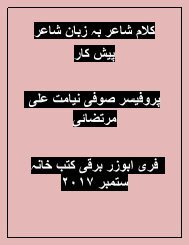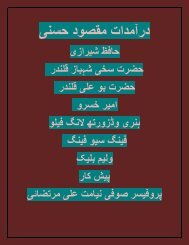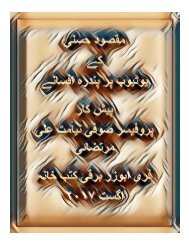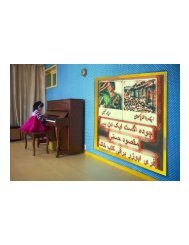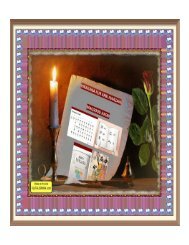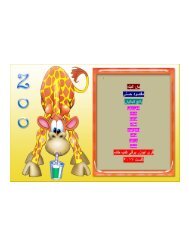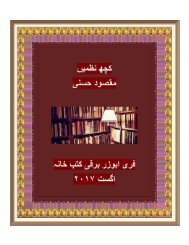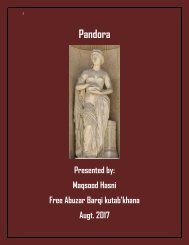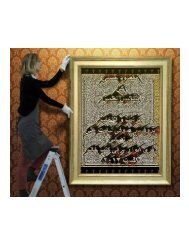You also want an ePaper? Increase the reach of your titles
YUMPU automatically turns print PDFs into web optimized ePapers that Google loves.
Japanese Poetry<br />
Presented by<br />
Maqsood Hasni<br />
Free Abuzar Barqi Kutab’khana<br />
Aug. 2017<br />
1
History of Japanese Poetry<br />
The classical Japanese <strong>poetry</strong> is referred as waka.<br />
Man’yoshu, dating back to the middle of 7th century, is<br />
the oldest book of Japanese <strong>poetry</strong>. Man’yoshu contains<br />
20 volumes of waka. The authors of most of these poems<br />
2
3<br />
are unknown, but they ranged from aristocrats to the<br />
general public, women as well as eminent poets of the<br />
time such as Nukata no Okimi and Kakinomoto Hitomaro.<br />
During the period of Chinese influence, Chinese poets<br />
recited poems in the courts of the Japanese royals and<br />
the aristocrats. Japanese poets even went to China to<br />
study <strong>poetry</strong>. Poetry tradition was so much ingrained in<br />
Japanese culture that waka (<strong>poetry</strong>) was used to write<br />
letters and community.<br />
During the Heian period (794 and 1185), Japanese royals<br />
and aristocrats organized waka recitation contest.<br />
Notable works in this period is Wakan Roeishu, which<br />
was compiled by Fujiwara no Kinto, Tale of Genji by<br />
Poetess Murasaki Shikibu, and The Pillow Book, whose<br />
author is unknown.<br />
In the 12th century, new <strong>poetry</strong> forms Imayo and Renga<br />
developed. Recitation of Imayo was accompanied with<br />
music and dance, and Renga was written in a
communication form between two people.<br />
Haikai (also called Renku) developed during the Edo<br />
period (1602–1869). Matsuo Basho was the great haikai<br />
poet of this era. He also developed haibun, a <strong>poetry</strong> style<br />
that combined haiku with prose. During Edo period, poets<br />
collaborated with painters and blended <strong>poetry</strong> with<br />
paintings, which gave birth to new visual <strong>poetry</strong> form<br />
called haiga. Notable amongst poet-painters is Yosa<br />
Buson. He wrote haiku poems in his paintings. Senryu, a<br />
satirical poem in haikai form, developed in the late Edo<br />
period.<br />
By the 19th century, major Japanese <strong>poetry</strong> forms were<br />
already developed. With the Western influence, freeform<br />
<strong>poetry</strong> style developed in Japan. This <strong>poetry</strong> style was<br />
called Jiyu-shi, literally freestyle <strong>poetry</strong>, or Shintai-shi,<br />
new form <strong>poetry</strong>. Shi is the Japanese word for Chinese<br />
<strong>poetry</strong>, but today it is used for modern Japanese <strong>poetry</strong><br />
style.<br />
4
5<br />
Japanese Death Poems: Written by Zen Monks and Haiku<br />
Poets on the Verge of Death Japanese Death Poems:<br />
Written by Zen Monks and Haiku Poets on the Verge of<br />
Death<br />
Waka<br />
Japan was heavily influenced by Chinese <strong>poetry</strong>;<br />
Japanese poets composed poems in Chinese language.<br />
The Japanese poems following the classical Chinese<br />
<strong>poetry</strong> are called kanshi. Classical Japanese poets also<br />
wrote <strong>poetry</strong> in Japanese language. All the poems<br />
written in Japanese language were referred as waka.<br />
Waka is a Japanese word for <strong>poetry</strong>. The Kokin-shu<br />
(905) Man’yoshu (7th century) are two books of<br />
Japanese <strong>poetry</strong> that contain waka in different patterns.<br />
Man’yoshu, which as 20 volumes, contain waka of<br />
different forms such as tanka (short poem), choka (long<br />
poem), bussokusekika (Buddha footprint poem), sedoka<br />
(repeating-the-first-part poem) and katauta (half poem).
By the time Kokin-shu was compiled, most of these<br />
<strong>poetry</strong> forms, except tanka, had vanished. Therefore,<br />
waka was used to refer tanka <strong>poetry</strong>. Tanka also gave<br />
birth to renga and haiku. Choka and sedoka are early<br />
<strong>poetry</strong> forms whereas renga, haikai, and haiku are later<br />
<strong>poetry</strong> forms.<br />
Waka: The Classical Japanese Poetry Forms<br />
Poetry Forms<br />
Pattern<br />
Meaning<br />
Katauta<br />
5,7,7<br />
Half Poem<br />
Tanka<br />
5,7,5,7,7<br />
6<br />
Short Poem
7<br />
Choka<br />
5,7,5,7,5,7,5,7,7<br />
Long Poem<br />
Bussokusekika<br />
5,7,5,7,7,7<br />
Buddha Footprint Poem<br />
Sedoka<br />
5,7,7,5,7,7<br />
Repeating-the-First-Part Poem<br />
Haikai<br />
When renga is composed in humorous and comic themes,<br />
it is called haikai. Haikai is referred as mushin renga or<br />
comic renga. Haikai <strong>poetry</strong>, sometimes also called hokku,<br />
is composed in three lines with nature and season as the<br />
dominant theme. Hokku or haikai <strong>poetry</strong> form gained<br />
prominence in the 17th century. Matsuo Basho
(1644-1694) was one of the early poets to perfect the art<br />
of hokku/haikai <strong>poetry</strong>.<br />
8<br />
Renga<br />
Renga is a linked-verse Japanese <strong>poetry</strong> from composed<br />
in tanka pattern. Renga was originally composed by two<br />
or more poets. Renga developed when poets tried to<br />
communicate through <strong>poetry</strong>. The first three lines of<br />
renga, in 5-7-5 syllables format, were composed by a<br />
poet and the remaining 7-7 syllables were composed by<br />
another. In ancient Japan, composing renga was a<br />
favorite pastime affairs of poets, aristocrats, even<br />
general public. The earliest record of renga poems is<br />
found in Kin'yo-shu, an anthology of poems compiled in<br />
about 1125.<br />
In the beginning, renga were based on light topic,<br />
however, by 15th century, there was a distinction drawn<br />
between ushin renga (serious renga) and mushin renga<br />
(comic renga).
Renga <strong>poetry</strong> contains at least 100 verses. The first<br />
stanza (the first three lines), of renga is called hokku.<br />
Hokku of a renga later developed into haiku <strong>poetry</strong>.<br />
A little cuckoo across a hydrangea, a haiga by Yosa<br />
Buson (1716 - 1784)<br />
A little cuckoo across a hydrangea, a haiga by Yosa<br />
Buson (1716 - 1784) | Source<br />
When the Japanese poets composed haiku and senryu,<br />
they used words in terms of sound effect. This was not<br />
possible when these Japanese <strong>poetry</strong> forms were<br />
adapted in other languages. The 5-7-5 pattern called<br />
kana (17 kana in total) in Japanese language was<br />
translated as 17 syllables in 5-7-5 format. Haiku<br />
were/are also written in 3-5-7, 3-5-3 and 5-8-5<br />
pattern.<br />
Today haiku are mostly written in three lines, in 17 or<br />
less syllables.<br />
9
10<br />
Haiku is not a sentence in three fragments.<br />
The best haiku are open ended.<br />
Haiku is about nature and season as experienced or<br />
observed by the poet.<br />
Haiku uses minimal punctuation.<br />
Metaphors, similes and other <strong>poetry</strong> elements are<br />
unnecessary in haiku.<br />
Haiku does not tell but shows the emotions as<br />
experienced by the poet.<br />
Haiku present specific moments rather than extensive<br />
picture.<br />
Haiku, senryu, haiga and tanka are used in both, singular<br />
as well as plural form.<br />
Haiku<br />
The word haiku combines two different words haikai and<br />
hokku. Haikai is a linked-verse Japanese poem in renga
<strong>poetry</strong> style and hokku is the name given to the first<br />
stanza of renga <strong>poetry</strong>. Haikai, a type of renga <strong>poetry</strong>,<br />
consists of at least 100 verses in 5-7-5-7-7 pattern.<br />
Haiku <strong>poetry</strong> form developed from hokku of haikai and<br />
became an independent <strong>poetry</strong> form in the 17th century;<br />
however, the word haiku was not used until 19th century.<br />
Haiku was named by Japanese poet Masaoka Shik.<br />
Haiku is non-rhyming Japanese <strong>poetry</strong> form. It is<br />
composed in three lines, in 5-7-5 format, 17 syllables in<br />
total. Haiku is about nature and plays with the imagery,<br />
metaphors and emotions of seasons.<br />
Japanese characters were developed from Chinese and<br />
Korean alphabets, which are basically pictograms. The<br />
style of haiku was perfectly compatible with the language<br />
because a single character could say many things.<br />
However, in other language such as English, an alphabet<br />
is just a letter that cannot evoke feelings and emotions,<br />
or even sensible meaning. Therefore, when haiku entered<br />
11
into English and other languages, there were few<br />
modifications. The three lines form was maintained in<br />
haiku, but the strictness of 17 syllables could not always<br />
be retained.<br />
The modern haiku does not strictly follow 17 syllables in<br />
5-7-5 format. Some haiku poets follow 5-3-5 format,<br />
whereas some do not even follow the uniform pattern of<br />
syllables. The most common haiku format is unrhymed<br />
three lines <strong>poetry</strong>.<br />
12<br />
Haiku <strong>poetry</strong> form was incorporated in the Western<br />
languages in the 19th century. Imagists popularized<br />
English haiku <strong>poetry</strong> in the early 20th century.<br />
Haiku Poetry<br />
Haiku: Rose<br />
Haiku about rose. Pictures of rose.<br />
Haiku: Nature<br />
Haiku were originally written about nature. Two haiku
13<br />
about nature and a video based on haiku about nature<br />
Senryu<br />
In the 18th century, Karai Senryu (1718-1790) composed<br />
short non-rhyming poems, about human foibles and<br />
ironies, in 5-7-5 form. His poems were called Senryu.<br />
Later, all the poems that followed the tradition of Karai<br />
Senryu were called senryu. Karai Senryu is the pen<br />
name of Karai Hachiemon.<br />
Senryu – a Japanese <strong>poetry</strong> form composed in 17<br />
syllables, in 5-7-5 format – is similar to haiku. Like haiku,<br />
there have been some modifications in senryu pattern, in<br />
modern times. The basic difference between haiku and<br />
senryu is, haiku is written about season and nature,<br />
whereas senryu is about the ironies of life. Sometimes it<br />
is hard to differentiate senryu with haiku because<br />
senryu can also be a commentary on nature or season.<br />
To differentiate a senryu with haiku you have to consider<br />
the tone. Thematic treatment in haiku is serious whereas
senryu are humorous or cynical.<br />
Normally, senryu presents setting, subject and action. It<br />
is a commentary on human nature in satirical or<br />
humorous tone.<br />
Haiga by Vinaya<br />
Haiga by Vinaya<br />
Haiga<br />
Haiga: Love<br />
Haiga about carnal, ethereal and motherly love. Tips on<br />
how to create Haiga.<br />
Haiga<br />
Haiga (hai=poem/haiku; ga=painting) is a visual <strong>poetry</strong><br />
form, which originated in China in the 7th century, and<br />
was perfected in Japan the 17th century. Painting, <strong>poetry</strong><br />
and calligraphy were called ‘Three Perfections’ in<br />
ancient China. The Three Perfections was first practiced<br />
14
during the Tang Dynasty (618-907). The Three<br />
Perfections of Tang Dynasty heavily influenced Japanese<br />
art and literature.<br />
Calligraphy, the art of handwriting, was highly regarded<br />
in ancient China. Artists wrote deep and profound lines,<br />
in beautiful script, over the painting. Japanese artists<br />
emulated the tradition of writing beautiful lines over a<br />
painting. Painting and <strong>poetry</strong> became complimentary art<br />
forms. Poets with painting ability, or the painters who<br />
were poets, created visual <strong>poetry</strong>.<br />
During the Edo period (1602–1869) haiku and senryu<br />
were combined with painting and calligraphy. Thus, a new<br />
visual <strong>poetry</strong> form was born, it was called Haiga. Haiga is<br />
a haiku/senryu poem written over a painting or<br />
photograph.<br />
15<br />
Haiga is a <strong>poetry</strong> blended with picture that tells about<br />
profound observation of life, living and the world.<br />
Thematically the <strong>poetry</strong> in the haiga is similar to the
picture. Haiga was initially painted over wooden blocks,<br />
stones, cloths, and paper and used as room decoration.<br />
Haiga is highly regarded in Zen Buddhism. Creating haiga<br />
is thought to be a type of Buddhist meditation.<br />
16<br />
Modern haiga poet/artist combines haiku/senryu with<br />
digital pictures. The modern haiga normally presents a<br />
haiku or senryu written on painting or photograph.<br />
Given a choice between different Japanese <strong>poetry</strong> forms,<br />
what do you choose?<br />
Haiku<br />
Senryu<br />
Haiga<br />
Tanka<br />
See results<br />
Tanka<br />
In the beginning, when Japanese <strong>poetry</strong> forms were not
developed, waka was used to denote all kinds of poem.<br />
Waka literally means classical Japanese <strong>poetry</strong>.<br />
Man’yoshu, which dates back to the middle of 7th<br />
century, is the oldest book of Japanese <strong>poetry</strong>.<br />
Man’yoshu contains long and short poems. Man’yoshu<br />
categorizes short poems as waka and long poems as<br />
choka. The word waka was later replaced with tanka.<br />
Tanka is the modern name for waka. It is one of the<br />
oldest Japanese <strong>poetry</strong> styles.<br />
Tanka is non-rhyming Japanese <strong>poetry</strong> form composed<br />
in five lines, in 5-7-5-7-7 format, 31 syllables in total. It<br />
consists of two elements. The first three lines (5-7-5) is<br />
called kami-no-ku (literally upper phrase) and the last<br />
two lines (7-7) is called shimo-no-ku (literally lower<br />
phrase).<br />
In the ninth and tenth centuries, short poems dominated<br />
Japanese <strong>poetry</strong> styles. Kokinshu is one of the earliest<br />
collections of tanka. However, tanka <strong>poetry</strong> form was<br />
17
18<br />
almost lost for one thousand years. Japanese poet,<br />
essayist, and critic Masaoka Shiki (1867-1902) is<br />
credited for the revival of tanka <strong>poetry</strong>, and the<br />
invention of haiku from hokku (haikai). Masaoka lived<br />
during the reign of Japanese emperor Meiji Tenno<br />
(1852-1912). Meiji is credited for the development of<br />
modern Japan. Masaoka tried to do the same thing in<br />
Japanese <strong>poetry</strong>.<br />
Kokin-shu, an anthology of <strong>poetry</strong>, was compiled by a<br />
court noble Ki Tsurayuki in 905. Kokin-shu styles of<br />
<strong>poetry</strong> ruled Japan for about one thousand years.<br />
However, Masaoka praised the <strong>poetry</strong> styles in<br />
Man’yoshu (7th century) and degraded Kokin-shu.<br />
Man’yoshu contains long and short <strong>poetry</strong> forms. Tanka<br />
is a short <strong>poetry</strong> form in Man’yoshu.<br />
The modern tanka <strong>poetry</strong> form was revived in the late<br />
1980s by Japanese poetess Tawara Machi.<br />
Tanka: Poems for Kids - and adults
If a haiku is usually (mistakenly) thought of as a 3-line,<br />
5-7-5 syllable poem, then the tanka would be a 5-line,<br />
5-7-5-7-7 syllable poem. However, as with haiku, it’s<br />
better to think of a tanka as a 5-line poem with 3 short<br />
lines (lines 2, 4, 5) and 2 very short lines (lines 1 and 3).<br />
While imagery is still important in tanka, the form is a<br />
little more conversational than haiku at times. It also<br />
allows for the use of poetic devices such as metaphor<br />
and personification (2 big haiku no-no’s).<br />
Like haiku, tanka is a Japanese poetic form.<br />
*****<br />
19
While I’m sure there are problems with my attempt, here<br />
is my tanka attempt, which you can use as an example of<br />
the form:<br />
Chopin’s waltzes<br />
turn circles in my head<br />
for hours<br />
as I think of her hand<br />
turning the world inside out<br />
Somonka: Poetic Forms<br />
By: Robert Lee Brewer | October 17, 2013<br />
1<br />
The somonka is a Japanese form. In fact, it’s basically<br />
two tankas written as two love letters to each other (one<br />
tanka per love letter). This form usually demands two<br />
authors, but it is possible to have a poet take on two<br />
personas. .<br />
Here’s an example somonka:<br />
“Sugar,” by Robert Lee Brewer<br />
20
I’m waiting to die;<br />
I think it will happen soon–<br />
this morning, I saw<br />
two bright hummingbirds battling<br />
over some sugar water.<br />
I know; I was there.<br />
I chased after them for you<br />
until thirst stopped me.<br />
Fetch me some water. I have<br />
a little sugar for you.<br />
*****<br />
Get your <strong>poetry</strong> published.<br />
*****<br />
Senryu<br />
By: Robert Lee Brewer | May 23, 2013<br />
0<br />
It’s been two months since our last poetic form challenge<br />
and the April PAD Challenge is over, so let’s get another<br />
one started.<br />
21
This time around, the challenge is to write senryu, which<br />
is a variation of the haiku. As with haiku, senryu are most<br />
often 3-line poems containing 17 (or fewer)<br />
syllables–often in a 5-7-5 pattern. Senryu does not<br />
include a cutting or seasonal word, and it’s usually about<br />
human issues (not nature, as is the case with haiku).<br />
In fact, many people write poems that they call haiku that<br />
are really senryu. So in a way, it’s a form of <strong>poetry</strong> that<br />
is often suffering from identity theft and mistaken<br />
identity.<br />
OK, so that’s the form.<br />
Here are the guidelines for competing in this challenge:<br />
Write and share original and previously unpublished<br />
senryu in the comments below (on this specific<br />
post).<br />
<br />
Deadline for entries: May 31, 11:59 p.m. (Atlanta,<br />
Georgia time).<br />
<br />
No entry fee.<br />
22
Include your name as you would like it to appear in<br />
print (just in case you’re chosen as a winner).<br />
Speaking of winners, the top senryu (and maybe a<br />
few extra, since the form is so short) will be<br />
published in a future issue of Writer’s Digest<br />
magazine in the Poetic Asides Inkwell column.<br />
Anyone and everyone (from any location on the<br />
globe) is encouraged to participate. It’s free and fun.<br />
Note to new poets: You’ll have to register on the site<br />
(don’t worry; it’s free) to comment. And for your<br />
first few comments, you may have to wait for one of<br />
us editors to approve your comment. Don’t worry;<br />
we’ll get to you–and then, after that first approval,<br />
you should be good to go into the future.<br />
Good luck!<br />
Katauta Poems<br />
The katauta is a Japanese poetic form that is actually<br />
considered an incomplete or half-poem. It’s a 3-liner that<br />
follows either 5-7-5 or more commonly 5-7-7 syllables<br />
23
per line. Sounds like a haiku or senryu, right? But this<br />
poem is specifically addressed to a lover.<br />
When paired together, multiple katautas act as a<br />
question and answer conversation between lovers to<br />
form sedoka. If the concept of sedoka sounds familiar,<br />
it’s similar to somonka, in which 2 tankas are written as<br />
love letters.<br />
*****<br />
Here’s my attempt at a Katauta:<br />
Untitled Katauta, by Robert Lee Brewer<br />
Why do winter stars<br />
shine brighter than summer stars<br />
as if they are shards of glass?<br />
And while we’re at it, here’s a Sedoka:<br />
Untitled Sedoka, by Robert Lee Brewer<br />
why do winter stars<br />
shine brighter than summer stars<br />
as if they are shards of glass?<br />
24
don’t blame the seasons<br />
on the ever changing heat<br />
of your lover’s quick embrace.<br />
*****<br />
Dodoitsu: Poetic Forms<br />
By: Robert Lee Brewer | July 14, 2015<br />
0<br />
Ready to learn a new poetic form? And yeah, you know<br />
that a new WD Poetic Form Challenge is just around the<br />
corner.<br />
The dodoitsu is a Japanese poetic form developed<br />
towards the end of the Edo Period, which came to an end<br />
in 1868. As with most Japanese forms, the dodoitsu does<br />
not have meter or rhyme constraints, focusing on<br />
syllables instead.<br />
This 4-line poem has seven syllables in the first three<br />
lines and five syllables in the fourth–and final–line. The<br />
dodoitsu often focuses on love or work with a comical<br />
twist. While my examples below do not have titles, I<br />
25
haven’t found any word on whether dodoitsu traditionally<br />
have titles or not.<br />
*****<br />
Here is an example focused on work:<br />
when a geologist speaks<br />
& the earth trembles seven<br />
meteorologists get<br />
sucked in a twister<br />
Here is an example focused on love:<br />
i gave her all my heart &<br />
heartache but she returned it<br />
with the admission they gave<br />
her severe heartburn<br />
*****<br />
Mondo: Poetic Form<br />
By: Robert Lee Brewer | February 27, 2017<br />
0<br />
26
Some folks may remember me covering katauta (and<br />
sedoka) poems last December. Today’s poetic form<br />
mondo is a close relative of those forms.<br />
Mondo Poems<br />
Mondo poems are often very brief collaborative affairs<br />
that present a question and answer in the style of trying<br />
to glean meaning from nature. Mondos can be as short<br />
as a one-liner or as long as two 5-7-7 syllable stanzas<br />
(the first stanza presenting the question; the second the<br />
answer). Examples below.<br />
*****<br />
Here’s my attempt at a one-line Mondo:<br />
Untitled, by Robert Lee Brewer<br />
why do winter stars shine brighter? i can’t hear them<br />
laugh.<br />
And here’s a two-stanza Mondo:<br />
Untitled, by Robert Lee Brewer<br />
27
why do winter stars<br />
shine brighter than summer stars<br />
and why do i notice them?<br />
i can’t hear them laugh,<br />
but i remember the way<br />
they once entered the darkness.<br />
*****<br />
If mondo seems a little too much like sedoka, I totally<br />
understand. I think the main difference is a focus on<br />
nature and trying to attain a zen-like meaning from<br />
natural source material.<br />
*****<br />
Katauta: Poetic Form<br />
By: Robert Lee Brewer | December 19, 2016<br />
1<br />
Let’s look at one or two more poetic forms before the<br />
end of the year, starting with the katauta poem.<br />
28
Katauta Poems<br />
The katauta is a Japanese poetic form that is actually<br />
considered an incomplete or half-poem. It’s a 3-liner that<br />
follows either 5-7-5 or more commonly 5-7-7 syllables<br />
per line. Sounds like a haiku or senryu, right? But this<br />
poem is specifically addressed to a lover.<br />
When paired together, multiple katautas act as a<br />
question and answer conversation between lovers to<br />
form sedoka. If the concept of sedoka sounds familiar,<br />
it’s similar to somonka, in which 2 tankas are written as<br />
love letters.<br />
*****<br />
Here’s my attempt at a Katauta:<br />
Untitled Katauta, by Robert Lee Brewer<br />
why do winter stars<br />
shine brighter than summer stars<br />
as if they are shards of glass?<br />
And while we’re at it, here’s a Sedoka:<br />
Untitled Sedoka, by Robert Lee Brewer<br />
29
why do winter stars<br />
shine brighter than summer stars<br />
as if they are shards of glass?<br />
don’t blame the seasons<br />
on the ever changing heat<br />
of your lover’s quick embrace.<br />
*****<br />
Gogyohka: Poetic Form<br />
By: Robert Lee Brewer | October 20, 2014<br />
0<br />
If only a poetic form existed that could be both concise<br />
and free. Oh wait a second, there’s gogyohka!<br />
Gogyohka was a form developed by Enta Kusakabe in<br />
Japan and translates literally to “five-line poem.” An<br />
off-shoot of the tanka form, the gogyohka has very<br />
simple rules: The poem is comprised of five lines with<br />
one phrase per line. That’s it.<br />
*****<br />
30
What constitutes a phrase in gogyohka?<br />
From the examples I’ve seen of the form, the definition of<br />
phrase is in the eye of the beholder. A compound or<br />
complex sentence is probably too long, but I’ve seen<br />
phrases as short as one word and others more than five<br />
words.<br />
So it’s a little loose, which is kind of the theory behind<br />
gogyohka. It’s meant to be concise (five lines) but free<br />
(variable line length with each phrase). No special<br />
seasonal or cutting words. No subject matter<br />
constraints. Just five lines of poetic phrases.<br />
Here’s my attempt at a Gogyohka:<br />
“Halloween”<br />
Ghosts hang<br />
from the willow<br />
as the children run<br />
from one door<br />
to the next.<br />
*****<br />
31
32<br />
Haibun Poems: Poetic Form<br />
By: Robert Lee Brewer | September 3, 2012<br />
0<br />
The haibun is the combination of two poems: a prose<br />
poem and haiku. The form was popularized by the 17th<br />
century Japanese poet Matsuo Basho. Both the prose<br />
poem and haiku typically communicate with each other,<br />
though poets employ different strategies for this<br />
communication—some doing so subtly, while others are<br />
more direct.<br />
The prose poem usually describes a scene or moment in<br />
an objective manner. In other words, the pronoun “I”<br />
isn’t often used—if at all. Meanwhile, the haiku follows the<br />
typical rules for haiku.<br />
Here is my attempt at a haibun poem:<br />
“1985”<br />
In the shadow of the Nevado del Ruiz, rice farmers woke<br />
as if on any other morning. Their daily pleasures and
worries were the same as always. Even the smoke and<br />
eruptions that afternoon were familiar—though masked<br />
by a thunderstorm—no one aware of the approaching<br />
lahars.<br />
not the sound<br />
but drops of rain<br />
scatter ants<br />
*****<br />
As you may have guessed, a new poetic form challenge is<br />
around the corner. It’d probably be a good idea to work<br />
on your haibuns today and share them tomorrow.<br />
*****<br />
Haiku Revisited<br />
By: Robert Lee Brewer | August 8, 2007<br />
0<br />
Michael Dylan Welch, who wrote on haiku for the 2005<br />
Poet’s Market, stopped by and offered some great advice<br />
in the comments to my “Haiku: Easy or Hard?” post from<br />
earlier this week. While it’s probably best to read the<br />
33
comments first-hand, I figured I’d make it easy on people<br />
since the advice is very useful.<br />
Some highlights:<br />
<br />
“My sense of things is that practically no current<br />
literary haiku writers believe the 5-7-5 pattern of<br />
syllables is applicable in English (in Japanese they<br />
count sounds, not syllables, which is why a<br />
one-syllable word like ‘scarf,’ in English, is counted<br />
as FOUR sounds when said in Japan, something like<br />
‘su-ka-ar-fu’), so I’m not sure I’d call 5-7-5 a<br />
‘traditional’ viewpoint in English. More like a<br />
traditional misunderstanding.”<br />
“Rather, what matters most in the tradition of haiku<br />
is kigo (season word) and kireji (cutting word), as<br />
well as objective sensory imagery (thus one<br />
wouldn’t say that rain ‘stampedes’ the mud, because,<br />
as interesting as that is, it shows your<br />
interpretation and lacks the objectivity that lets<br />
readers have their own reaction to a carefully<br />
crafted image).”<br />
34
35<br />
“At any rate, I always like to quote philosopher<br />
Roland Barthes on haiku. He said that ‘The haiku has<br />
this rather fantasmagorical property: that we<br />
always suppose we ourselves can write such things<br />
easily.’ Paradoxically, haiku is both easy and hard.”<br />
Welch also provided to links to check out:<br />
1. His essay “Becoming a Haiku Poet” at<br />
http://www.haikuworld.org/begin/mdwelch.apr200<br />
3.html<br />
2. Keiko Imaoka’s essay “Forms in English Haiku” at<br />
http://asgp.org/agd-poems/keiko-essay.html<br />
I would like to thank Welch, who is an expert in his field,<br />
for sharing so much great information with everyone.<br />
This is what having a community of poets is all about as<br />
far as I’m concerned.<br />
Haiku, Senryu, Haiga and Tanka<br />
The Chinese contribution in the development of Japanese<br />
script and literature is immense. Even though the history<br />
of Japanese literature goes beyond 7th century AD,<br />
much of the Japanese literature took inspiration from
Chinese literature during the Tang Dynasty (618-907) in<br />
China.<br />
Kojiki (712) and Nihonshoki (720) are the earliest<br />
records of Japanese literature. Kojiki and Nihonshoki are<br />
the books of Japanese mythology, history and poems.<br />
Mythology and history in these books were recorded<br />
from the oral tradition by Hieda no Are and credited to<br />
Yasumaro. The poems in these books are said to be<br />
composed by Japanese God Susanoo.<br />
In the beginning, Japanese poets used Chinese language<br />
to express their emotions, observations and insights.<br />
After the hundred years of writing in foreign language<br />
and form, Japanese poets developed a native style, which<br />
became integral to Japanese culture.<br />
36<br />
This one of the hundred prints illustrating the Japanese<br />
<strong>poetry</strong> anthology called the Hyakunin isshu, which was<br />
compiled by the poet Fuhiwara Teika 1162-1241<br />
This one of the hundred prints illustrating the Japanese
37<br />
<strong>poetry</strong> antology called the Hyakunin isshu, which was<br />
compiled by the poet Fuhiwara Teika 1162-1241 | Source
38
39





